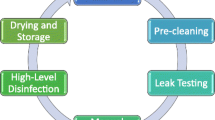Abstract
Background and Aims
In response to documented duodenoscope-related infectious outbreaks of multidrug-resistant organisms, the Food and Drug Administration has recommended a transition to duodenoscopes with innovative designs, including duodenoscopes with disposable components or fully disposable duodenoscopes. We aim to characterize the learning curve (LC) for a single-use disposable duodenoscope.
Methods
We performed a retrospective analysis of a prospectively collected database from 31 patients who underwent ERCP by a single, experienced operator using the EXALT Model D® (Boston Scientific, Marlborough) disposable duodenoscope at a single tertiary referral center. The LC for this device was described by the number of cases needed to achieve proficiency using cumulative sum (CUSUM) analysis. Number of attempts to cannulate and time to cannulate the desired duct were assessed as separate endpoints. The overall mean number of attempts and overall mean time to cannulation were used as the target values in the respective CUSUM analyses. Proficiency was defined as the number of procedures where an inflection point was reached in the CUSUM graph. This observation indicates improving operator performance as shown by a decrease in the number of attempts and shortening of cannulation time after the defined number of procedures.
Results
Overall, 31 patients underwent ERCP using the EXALT Model D disposable duodenoscope by a single experienced endoscopist. 6 (19%) patients had a native papilla and the majority of these procedures were classified as ASGE complexity level 2 or above. The procedure was completed using solely the disposable duodenoscope in 27 patients (87%), while a reusable duodenoscope was required for procedure completion in 4 patients (13%). The cross-overs were distributed evenly across the performance period. Procedure-related adverse events included: post-ERCP pancreatitis (3%), bleeding (3%) and no perforations. In the analyses of both endpoints, an inflection of the CUSUM curves is achieved at 10 cases, indicating sustained reduction of cannulation attempts and time to cannulation.
Conclusion
Among experienced pancreaticobiliary endoscopists, approximately 10 ERCPs is the threshold whereby procedure-related factors including cannulation success and procedural time improves. Procedure-related adverse events are consistent with those expected with reusable duodenoscopes. The need to cross-over from single-use duodenoscope to reusable duodenoscope did not appear to be related to the learning curve, as they were evenly distributed across the study period. These results can be used to guide adoption of single-use duodenoscopes into clinical practice.

Similar content being viewed by others
References
U.S. Food and Drug Administration. https://www.fda.gov/medical-devices/reprocessing-reusable-medical-devices/infections-associated-reprocessed-duodenoscopes. Accessed August 14, 2022.
Peery AF, Crockett SD, Murphy CC, Lund JL, Dellon ES, Williams JL et al. Burden and cost of gastrointestinal, liver, and pancreatic diseases in the United States: update 2018. Gastroenterology. 2019;156:254–72.e11. https://doi.org/10.1053/j.gastro.2018.08.063.
Kovaleva J, Peters FT, van der Mei HC, Degener JE. Transmission of infection by flexible gastrointestinal endoscopy and bronchoscopy. Clin Microbiol Rev. 2013;26:231–254. https://doi.org/10.1128/CMR.00085-12.
Rubin ZA, Murthy RK. Outbreaks associated with duodenoscopes: new challenges and controversies. Curr Opin Infect Dis. 2016;29:407–414. https://doi.org/10.1097/QCO.0000000000000290.
Epstein L, Hunter JC, Arwady MA, Tsai V, Stein L, Gribogiannis M et al. New Delhi metallo-beta-lactamase-producing carbapenem-resistant Escherichia coli associated with exposure to duodenoscopes. JAMA. 2014;312:1447–1455. https://doi.org/10.1001/jama.2014.12720.
Gromski MA, Sherman S. Technological review: developments in innovative duodenoscopes. Gastrointest Endosc. 2022;95:42–50. https://doi.org/10.1016/j.gie.2021.08.019.
Ross AS, Baliga C, Verma P, Duchin J, Gluck M. A quarantine process for the resolution of duodenoscope-associated transmission of multidrug-resistant Escherichia coli. Gastrointest Endosc. 2015;82:477–483. https://doi.org/10.1016/j.gie.2015.04.036.
CDC. CDC Statement: Los Angeles County/UCLA investigation of CRE transmission and duodenoscopes. https://www.cdc.gov/hai/outbreaks/cdcstatement-la-cre.html.
Saleem N, Ismail MK, Tombazzi CR, Soin S, Dhruva SS. Endoscopic transmission of carbapenem-resistant Enterobacteriaceae: implications for U.S. Food and Drug Administration approval and postmarket surveillance of endoscopic devices. Gastrointest Endosc. 2021;93:231–238. https://doi.org/10.1016/j.gie.2020.07.061.
Gromski MA, Sieber MS, Sherman S, Rex DK. Double high-level disinfection versus liquid chemical sterilization for reprocessing of duodenoscopes used for ERCP: a prospective randomized study. Gastrointest Endosc. 2021;93:927–931. https://doi.org/10.1016/j.gie.2020.07.057.
U.S Food and Drug Administration. https://www.fda.gov/news-events/press-announcements/fda-recommends-health-care-facilities-and-manufacturers-begin-transitioning-duodenoscopes-disposable. Accessed August 14, 2022.
U.S. Food and Drug Administration. . https://www.fda.gov/medical-devices/safety-communications/use-duodenoscopes-innovative-designs-enhance-safety-fda-safety-communication. Accessed August 14, 2022.
Jovani M, Ichkhanian Y, Parsa N, Singh S, Brewer Gutierrez OI, Keane MG et al. Assessment of the learning curve for EUS-guided gastroenterostomy for a single operator. Gastrointest Endosc. 2021;93:1088–1093. https://doi.org/10.1016/j.gie.2020.09.041.
Liu Z, Zhang X, Zhang W, Zhang Y, Chen W, Qin W et al. Comprehensive evaluation of the learning curve for peroral endoscopic myotomy. Clin Gastroenterol Hepatol. 2018;16:1420–6.e2. https://doi.org/10.1016/j.cgh.2017.11.048.
Van Rij AM, McDonald JR, Pettigrew RA, Putterill MJ, Reddy CK, Wright JJ. Cusum as an aid to early assessment of the surgical trainee. Br J Surg. 1995;82:1500–1503. https://doi.org/10.1002/bjs.1800821117.
Novick RJ, Stitt LW. The learning curve of an academic cardiac surgeon: use of the CUSUM method. J Card Surg. 1999;14:312–320. https://doi.org/10.1111/j.1540-8191.1999.tb01001.x. (discussion 21-2).
Cotton PB, Eisen G, Romagnuolo J, Vargo J, Baron T, Tarnasky P et al. Grading the complexity of endoscopic procedures: results of an ASGE working party. Gastrointest Endosc. 2011;73:868–874. https://doi.org/10.1016/j.gie.2010.12.036.
Andriulli A, Loperfido S, Napolitano G, Niro G, Valvano MR, Spirito F et al. Incidence rates of post-ERCP complications: a systematic survey of prospective studies. Am J Gastroenterol. 2007;102:1781–1788. https://doi.org/10.1111/j.1572-0241.2007.01279.x.
Freeman ML, Nelson DB, Sherman S, Haber GB, Herman ME, Dorsher PJ et al. Complications of endoscopic biliary sphincterotomy. N Engl J Med. 1996;335:909–918. https://doi.org/10.1056/NEJM199609263351301.
Author information
Authors and Affiliations
Corresponding author
Ethics declarations
Conflict of interest
Mark Gromski—consultant Boston Scientific, supported research Cook Medical. Stuart Sherman—consultant Boston Scientific, Olympus, Cook Medical. Nasir Saleem, Yan Tong—none.
Additional information
Publisher's Note
Springer Nature remains neutral with regard to jurisdictional claims in published maps and institutional affiliations.
An invited commentary on this article is available at https://doi.org/10.1007/s10620-024-08307-x.
Rights and permissions
Springer Nature or its licensor (e.g. a society or other partner) holds exclusive rights to this article under a publishing agreement with the author(s) or other rightsholder(s); author self-archiving of the accepted manuscript version of this article is solely governed by the terms of such publishing agreement and applicable law.
About this article
Cite this article
Saleem, N., Tong, Y., Sherman, S. et al. Assessment of the Learning Curve for a Single-Use Disposable Duodenoscope. Dig Dis Sci (2024). https://doi.org/10.1007/s10620-024-08305-z
Received:
Accepted:
Published:
DOI: https://doi.org/10.1007/s10620-024-08305-z




